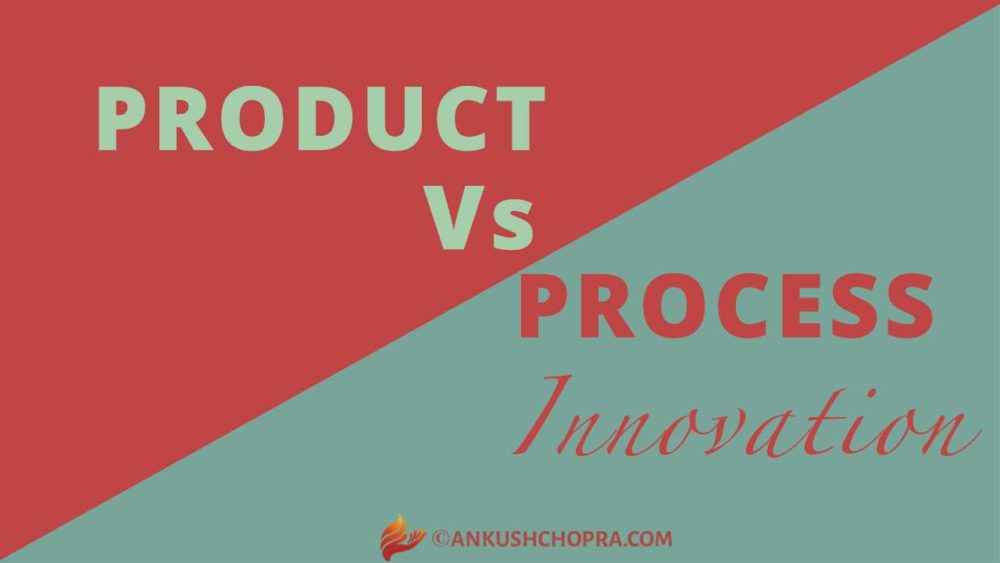There are more than a dozen types of innovations. But not all are equally important at all times. At various stages of industry evolution, some are more important than others. By choosing the right type of innovation to focus on you can be a more effective innovator.
Product vs Process Innovation
The most popular types of innovations are product and process innovations. Product innovation refers to a change in the product. It can be in two different forms. First, an improvement in the performance of a product. For example, an increase in digital camera resolution. Second, new features in a product. For example, the new iPhone 7 has dual cameras which did not exist in the previous iPhones. It is also a product innovation.
The second type of innovations that dominates innovation effort of firms is process innovation. It involves improvement in the process of producing a product. It includes changes across all the value chain activities. It includes improved inbound logistics, better media planning, or improved manufacturing process. For example, using instant demand data to plan production run is a process improvement. It can lead to lower inventory and lower stock outs.
While the product innovations are often visible to the customers, process changes are not
There are some significant differences between the two. While the product innovations are often visible to the customers, process changes are not. Product innovations target product improvement while process innovation targets cost improvements.
Technology Lifecycle and need for innovation
As technology evolves over its lifecycle, firms need to change their innovation focus. Early in the technology lifecycle, companies face high market and technological uncertainty. Technology and consumer needs are less understood. Firms experiment with product features, design, and performance. At the same time, consumers are not clear on what they need, want and like. In early stages, product innovation is the best way to reduce technological and market uncertainty. As a result, product innovation dominates in the early stages.
But later on, as technological and market uncertainty reduces, firms focus on efficiency. At that time, process innovation becomes more important.
The role of dominant design in innovation choices
Is there a clear point when firms begin to change their innovation focus from product to process?
Fortunately, research provides a clear answer here. When a dominant design emerges, it marks the point where this takes place. Before this point, firms experiment with the product. After this event, companies focus more on the process.
When dominant design emerges, product innovation passes the baton to process innovation
When dominant design emerges, product innovation passes the baton to process innovation
Technological, Market and Financial uncertainty and Innovation
Firms face many types risks. Three key ones are the market, technological, and financial uncertainty. Companies attempt to reduce these risks.
Early on in new technology, all three uncertainties are high. What the technology can provide and what the market wants are both unclear. As a result, whether there is money to be made is also not very clear.
As the dominant design emerges, technological and market uncertainty reduces. But, financial risk is still high because the cost structure is not yet optimized. Process innovation helps optimize the cost structure and reduce economic uncertainty.
Industry Stability And innovation
The emergence of dominance design is one driver of industry stability. It leads to shakeout and reduction in competition. Process innovation helps firms deepen their positions due to cost structures. Uncertainty declines and incumbents become entrenched.
the era of minor innovations is where most profits exist in an industry
Industry becomes stable, and innovations move from major to incremental ones. Most profits are made in this era. The risks firms took in the early stages begin to pay out now. In this sense, the era of minor innovations is where most profits exist in an industry.
While incremental innovations continue, the direction of change moves beyond product and process innovation. Firms begin to focus on channel innovation, packaging innovation, commercial innovation and financial innovation. This continues until the next discontinuity takes place.
Where are you in your industry evolution? Are you going through a discontinuity or on the cusp of one?





Please note: I reserve the right to delete comments that are offensive, or off-topic. If in doubt, read my Comments Policy.